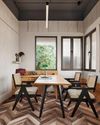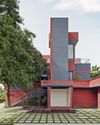
The landmark Intergovernmental Panel on Climate Change’s (IPCC) 2021 report warned of increased extreme heatwaves, droughts and flooding, as well as a key temperature limit on track to be broken in just over a decade. This highlights the urgency with which climate change is intensifying. With it, housing stability is increasingly coming under threat as well. These two inextricably linked issues have the potential to spark innovative ideas from the international design community and the community at large.
The design philosophy thus is to achieve an innovative, sustainable, cultural, and site-responsive housing prototype, which would be research-based, product/system-oriented, and ultra-low-cost. The goal is also to use waste-recycled and locally-available materials to achieve a Carbon Positive Affordable Housing for a typical, replaceable chosen site context. The low-income, natural disaster-prone estuarine belt of the Sundarbans in India serves as an example, which can be applied to other similar climatic site contexts with the potential of a much wider application.
THE CONTEXT
The site context chosen is for example only and is in the tropical Sunderbans estuary region of eastern India. The location has a hot and humid climate, and it is prone to natural disasters of annual seasonal flooding, cyclones, and hurricanes, as well as moderate earthquakes. The inhabitants are very low-income farmers and fishermen, who often lose their homes and livelihood to natural calamities. There are supposedly government ‘Pukka’ (structurally sound) housing loan schemes to self-build homes for a budget of INR 2.4 lakhs or approx US$3,120. This is still unaffordable, and therefore, the extra design effort to bring the cost significantly down is attempted here.
Diese Geschichte stammt aus der June 2022-Ausgabe von Architecture + Design.
Starten Sie Ihre 7-tägige kostenlose Testversion von Magzter GOLD, um auf Tausende kuratierte Premium-Storys sowie über 8.000 Zeitschriften und Zeitungen zuzugreifen.
Bereits Abonnent ? Anmelden
Diese Geschichte stammt aus der June 2022-Ausgabe von Architecture + Design.
Starten Sie Ihre 7-tägige kostenlose Testversion von Magzter GOLD, um auf Tausende kuratierte Premium-Storys sowie über 8.000 Zeitschriften und Zeitungen zuzugreifen.
Bereits Abonnent? Anmelden

A GRECIAN RETREAT
Shimona Bhansali imbues a subtle touch of opulence to this home in Mumbai

A BOLD STATEMENT
Dhampur Sugar Mills Limited's workspace in New Delhi designed and built by Officebanao adopts an industrial narrative

A BREATH OF FRAGRANT DESIGN IN DELHI'S HEART
An office that smells like perfumery; that is the vision that TWI brought to life in this office space designed for an acclaimed perfume company in India

MASTER OF ALL TRADES
The ethos of forward-thinking and ingenuity finds its architectural counterpart within the walls of Nikhil Kamath and Abhijeet Pai's office-a vision of organic design infused with the essence of India

A TOUCH OF OPULENCE
Designed by Aparna Kaushik, this Delhi office displays an interesting balance of classic aesthetics and contemporary sensibilities

THE WOODEN WONDERLAND
Priyanka and Piyush Mehra envision a stunning experience centre for Vikas Plywood

THE HUB: BUILDING COMMUNITIES
Studio Lotus designs a dynamic mixed-use community hub that activates Chennai's largest IT Park

THE WINNER'S PERCH
Baldiwala Edge designs a Singapore-based ship broker's office as a torch collector's paradise, offering a 360-degree bird's-eye view of the Mumbai skyline

THE DIRECTOR'S CABIN
Designed by Envisage, this office gives a new definition to the traditional notion of biophilia

Designing Corporate India
From weaving the magic of a Star Trek-themed command centre to crafting bespoke block-printed workstations, Vijaya Bhargav and Arnab Ghosh-the trailblazing co-founders of Ostraca-have astonishingly transformed a staggering 29 million square feet of office space for India's tech giants and global enterprises-all while maintaining a flat hierarchical company culture-fuelling a master class in corporate design